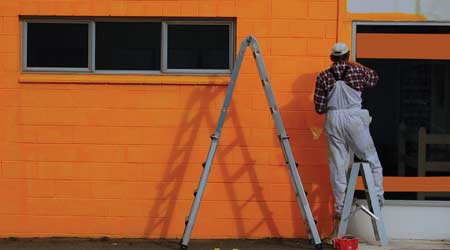 Painters dealing with an array of substrates should plan projects with preparation, application and cleanup in mind in order to produce quality, lasting jobs.
Painters dealing with an array of substrates should plan projects with preparation, application and cleanup in mind in order to produce quality, lasting jobs.Surface Issues: Matching Paints and Substrates
By understanding paint and coating options and surface challenges, managers can deliver successful applications
Most institutional and commercial facilities feature an array of painted surfaces that require regular attention in order to create positive impressions among building occupants and visitors. The challenge for maintenance managers and their departments in ensuring an appealing look for these surfaces when applying the most appropriate paint or coating.
By staying up to date on advances in the types of paints and coating frequently used in facilities and understanding the challenges presented by common substrate materials — including drywall, wood, metal and masonry — managers can be better equipped to successfully match paints to substrates for maximum effectiveness.
A new generation
The search for new paints and coating colors and additives is a high priority among manufacturers in their continuing efforts to provide products that make a unique, positive and lasting impression while withstanding the durability test. The product advances are important for maintenance departments because they mean more color choices, longer life and additional benefits that include low volatile organic compound (VOC) content and adaptability to an array of substrates. These factors draw positive attention to the facility, enhance the indoor environment at a low cost and increases property values in commercial spaces.
Six basic groups of paints and coating types are: interior paints and primers; exterior paints and primers; wood stains and finishes; floor coatings and sealers; and specialty paints.
Interior paints and coatings. Interior choices include hundreds of colors, and more one-coat primer and paint options with improved stain blocking, coverage, durability, abrasion resistance and antimicrobial additives.
Exterior paints. When dry, exterior paints provide a dense, hard shield that holds up well against ultraviolet (UV) rays. They are rain resistant in 60 minutes, resist fading and dirt, and have antimicrobial properties. A variety of new finishes are available, including: flat for walls; high-gloss for doors and furniture; and satin, semi-gloss, matte, and eggshell. They also come in hundreds of color choices for a variety of looks for any substrate.
Wood stains. Stains for new and old wood floors and trim offer a variety of shades and colors for interior use or exterior decks, sheds, barns and fences. Varnish, polyurethane and oil-based finish stains bring out natural color. Penetrating stains provide water resistance outdoors or near outside entries and tough, abrasion-resistant surfaces.
Floor coatings and sealers. Managers can choose from coating products such as clear, penetrating sealers for concrete and masonry that are water and salt repellent. This category also includes solvent-based acrylic masonry sealers with a clear, wet look and UV-resistant properties.
Specialty paints. These paints include high-gloss alkyd, acrylic, epoxy, urethane and water-reducible alkyd products. There are paints for aluminum, concrete, drywall, ferrous metal, galvanized steel, masonry, plastic, plywood, stucco and wood. Specialty paints also include flat and semi-gloss interior, low-odor, one-coat primers and paints.
Related Topics:














